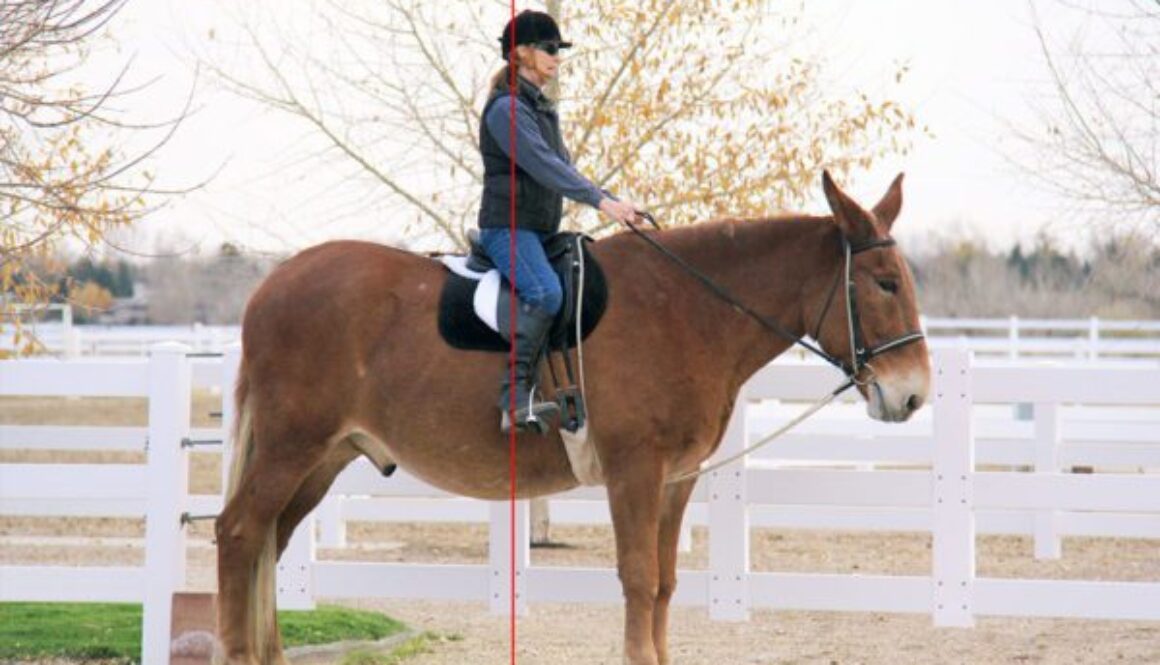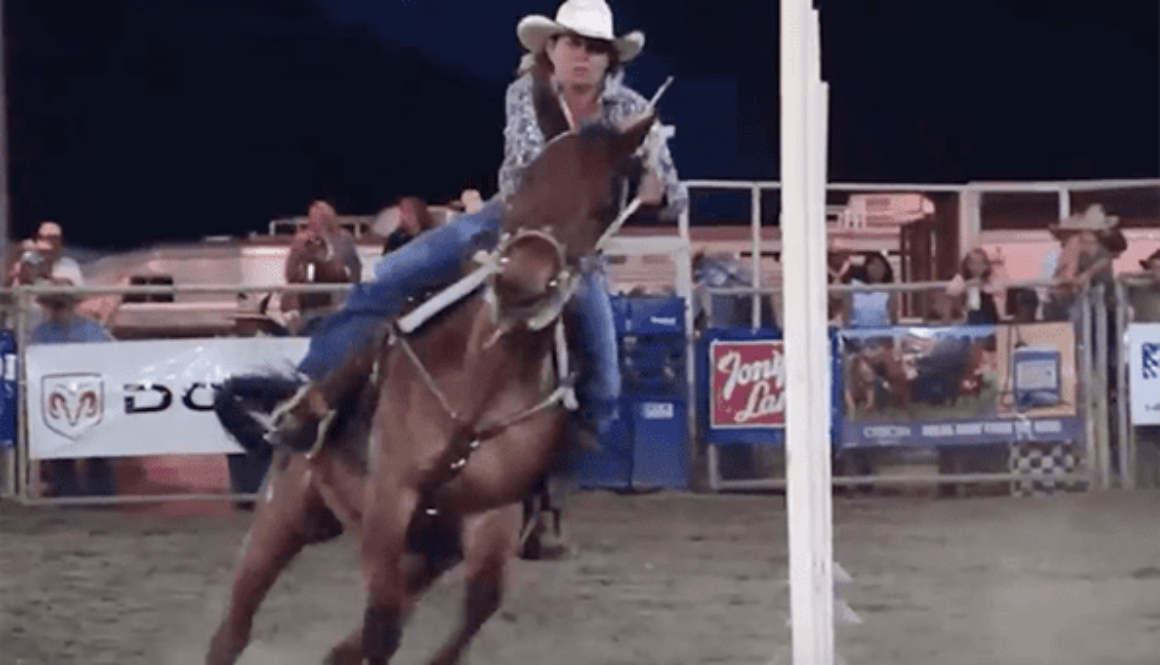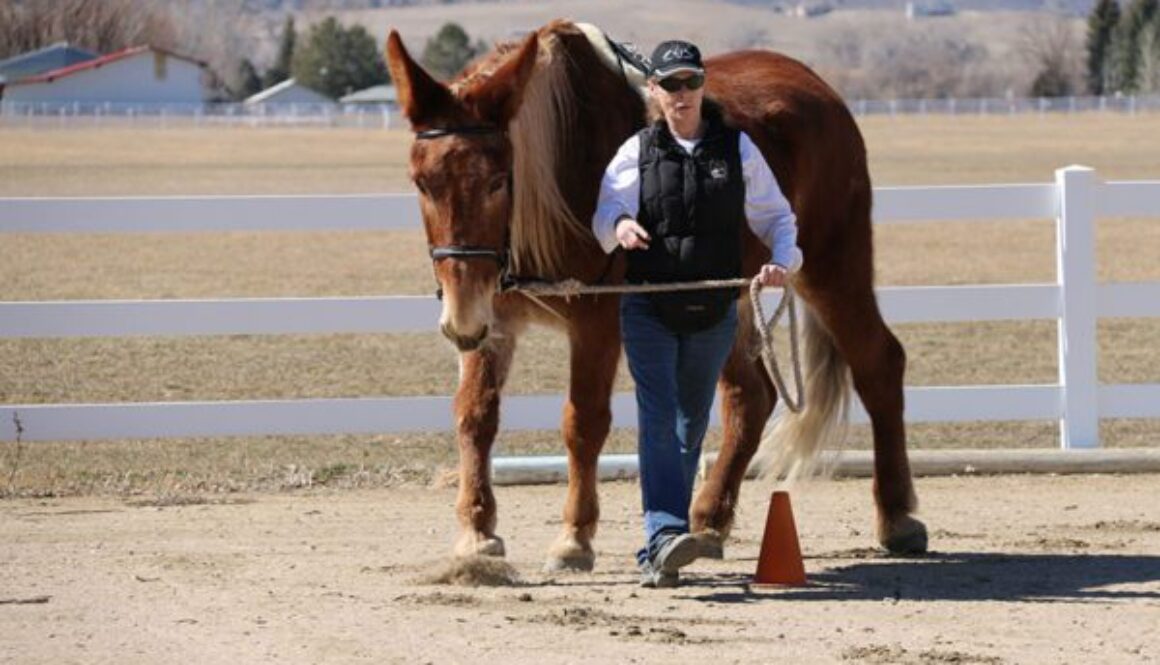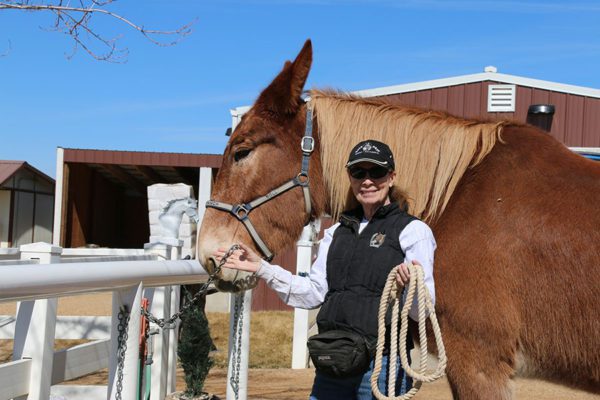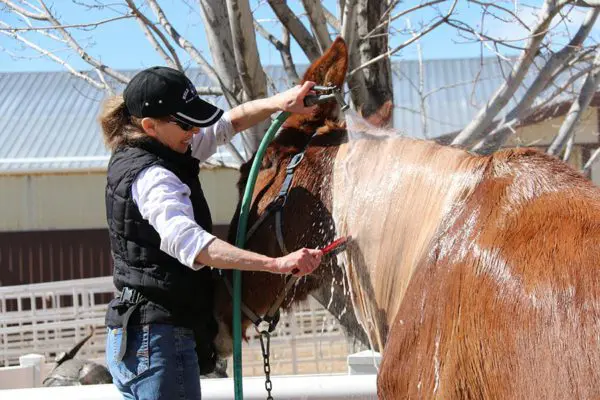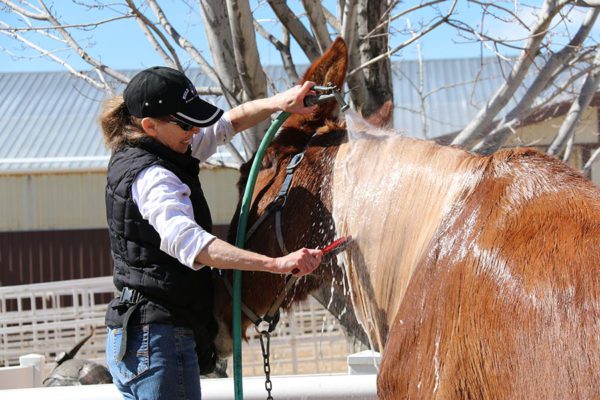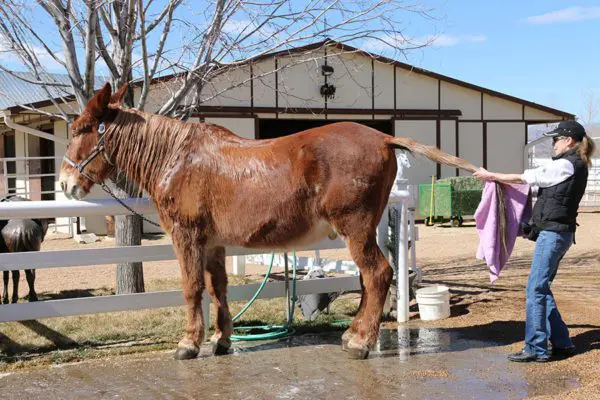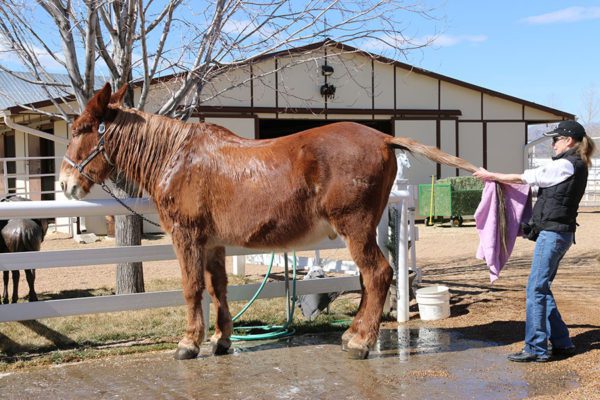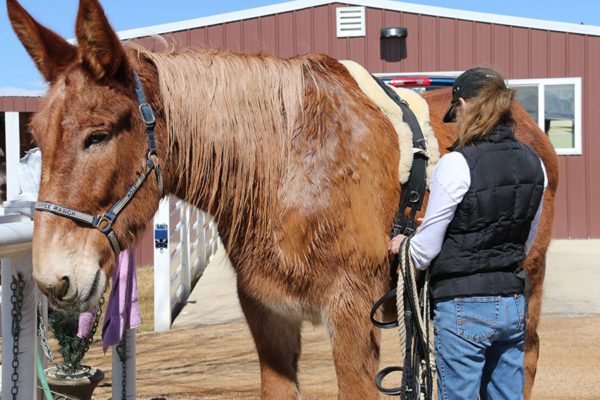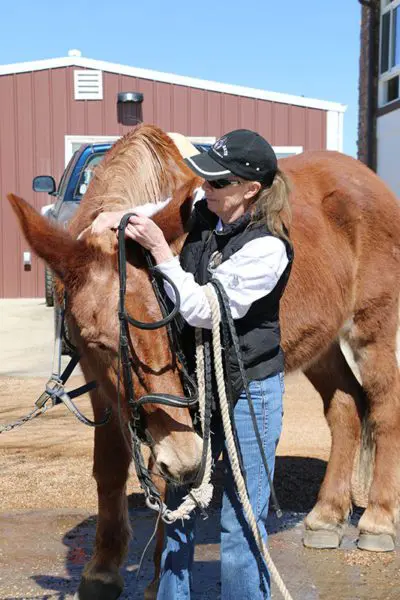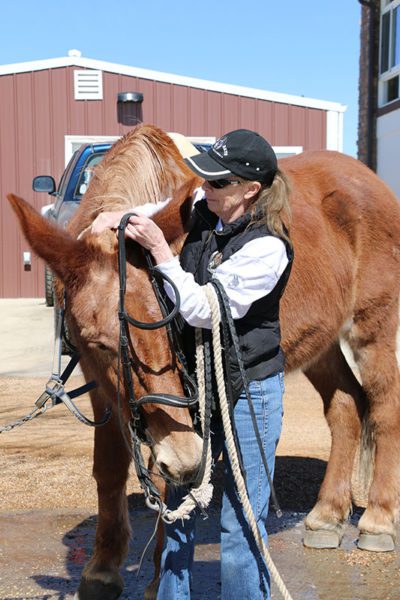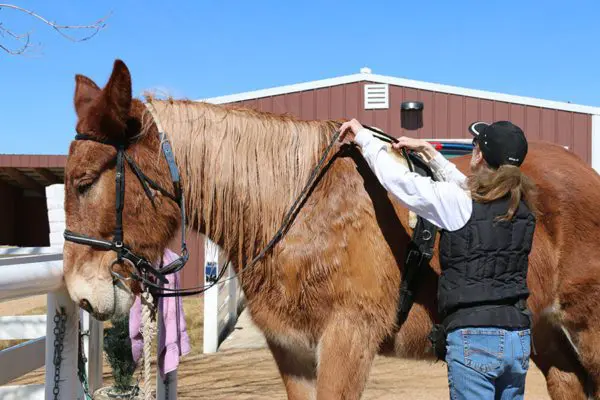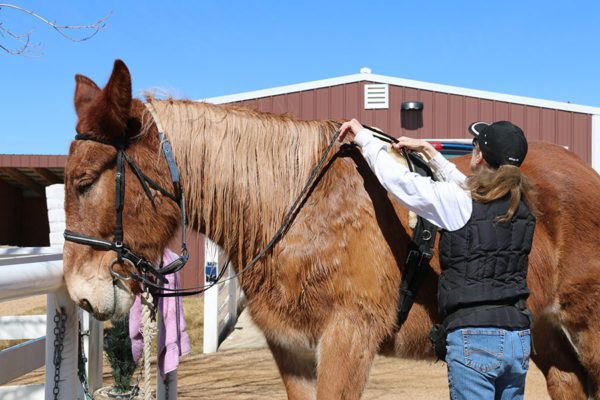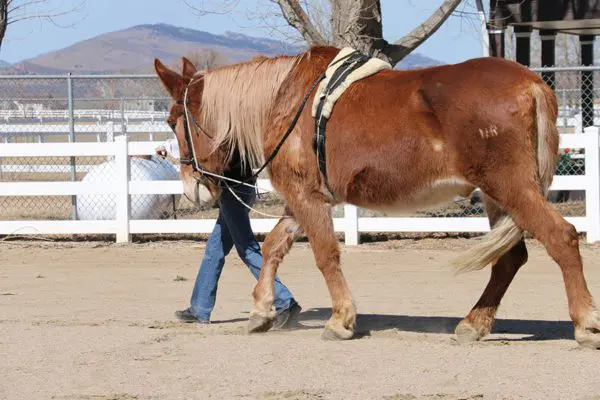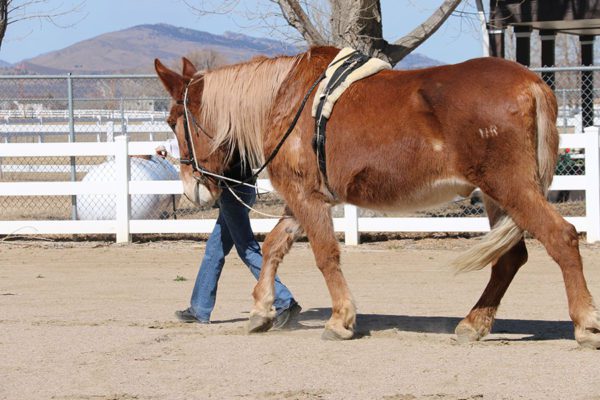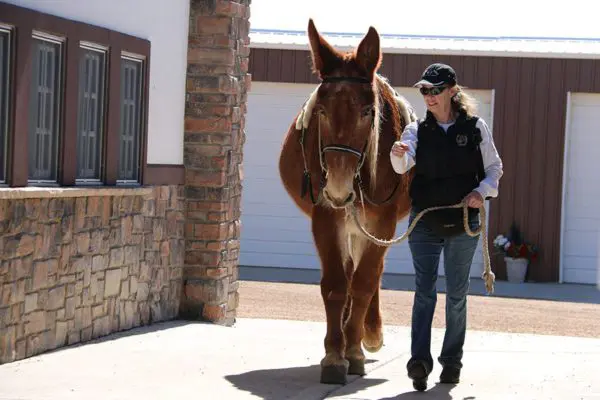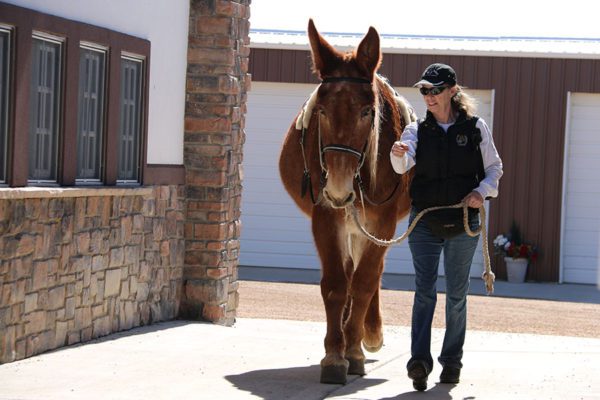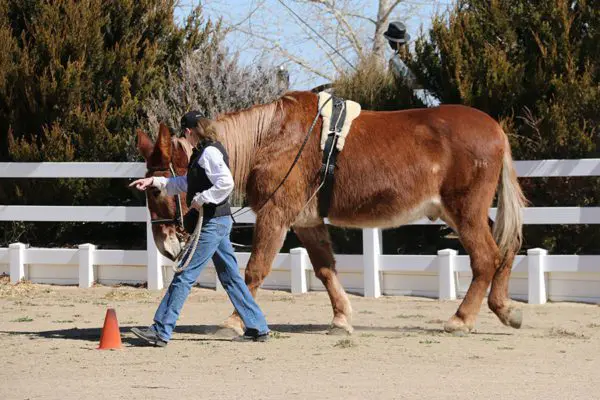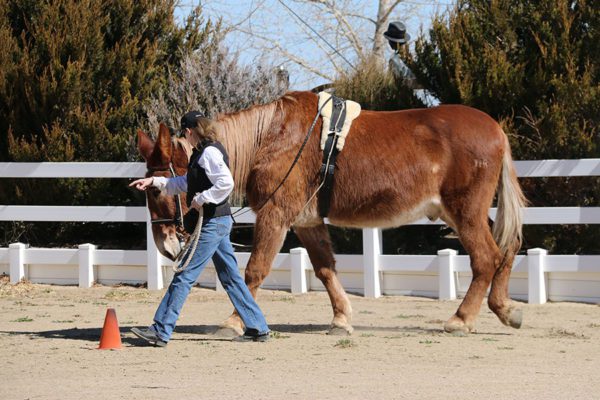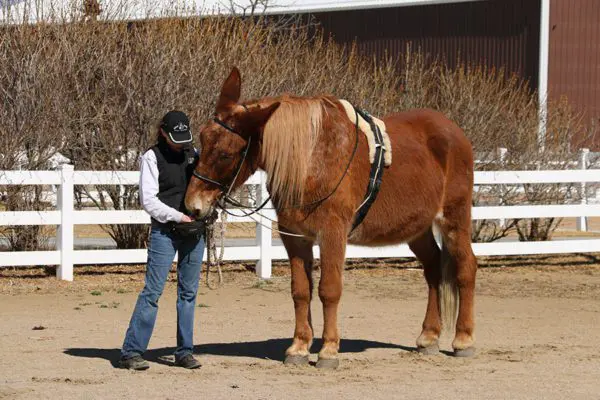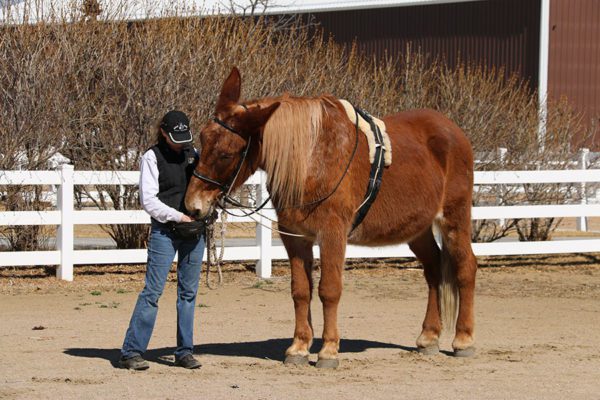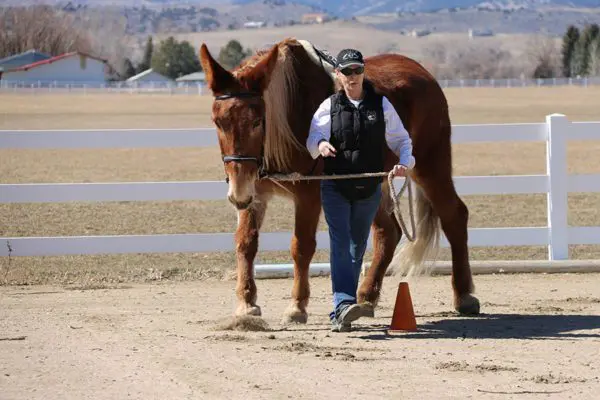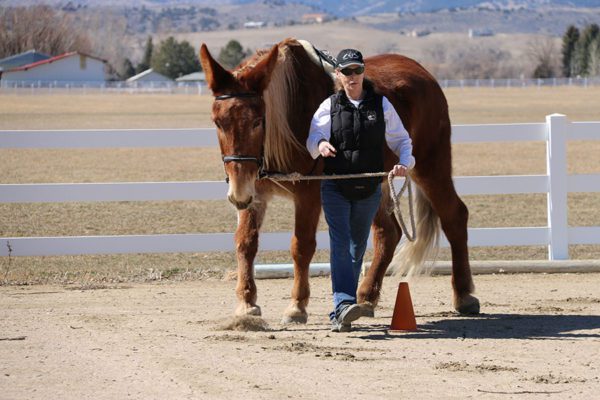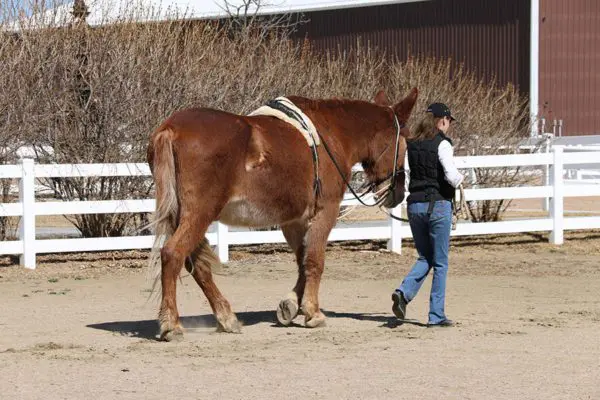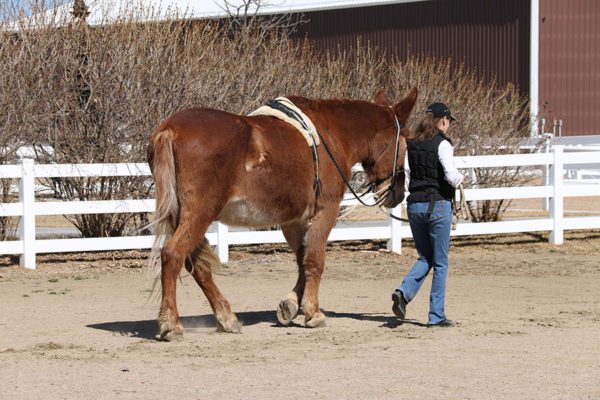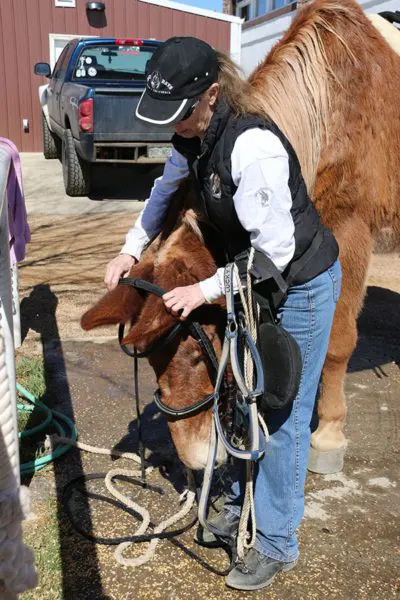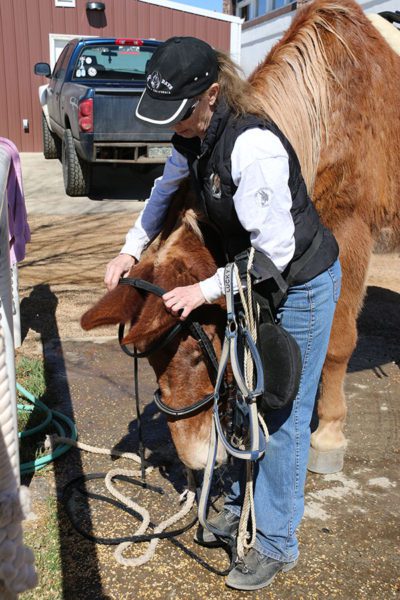MULE CROSSING: Keys To Successful Training, Part 2: Your Working Environment
By Meredith Hodges
The Work Station
It is important that your equine feels safe and comfortable in his surroundings. For this reason, you should use the same place each day to groom and prepare him for his lessons. In the beginning, use a small pen (approximately 400 to 500 square feet) that allows you access to your equine for imprinting, tying, leading and grooming, as described in DVDs #1 and #8 of my series, Training Mules & Donkeys (plus disc #9 when dealing with donkeys), and in Part 1 of Equus Revisited. All the while, you will also be teaching him good ground manners. Remember, routine fosters confidence and trust.
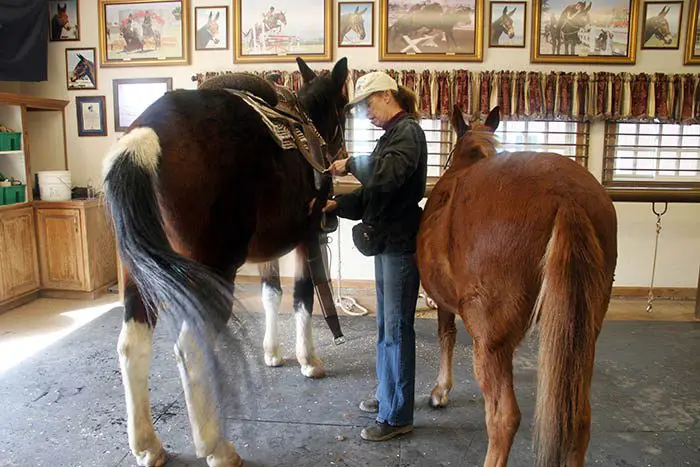 Once your equine has mastered tying and leading in the small pen, he can then move on to a designated work station where he will not only be groomed, but will also learn to accept tack in preparation for the round pen. This should be a place that has a good stout hitch rail and easy access to your tack and grooming equipment.
Once your equine has mastered tying and leading in the small pen, he can then move on to a designated work station where he will not only be groomed, but will also learn to accept tack in preparation for the round pen. This should be a place that has a good stout hitch rail and easy access to your tack and grooming equipment.
When working around your equine at the work station, pay special attention to his body language. If he becomes tense or skittish, acknowledge his concerns with a stroke on his neck, supportive words to him and a reward of crimped oats when he settles down. Always learn to wait for him to settle down before you proceed.
Don’t make too much out of unimportant details. For instance, if your equine is pawing the ground, don’t insist that he be still unless you need to approach him and do something specific with him. Many of your animal’s anxious behaviors get unintentionally rewarded by giving him too much attention, which can actually cause the behaviors to escalate. If you ignore pawing, cribbing, throwing of the head, pushing with the nose, stomping and other anxious behaviors, they will lessen over time, provided that you step in, ask him to stop and reward your animal, but only when he is being quiet.
Before you begin to groom your equine—whether you’re going to brush, vacuum or clip him—make sure you give him the time to figure out what you are going to do. He will exhibit his acceptance with a sigh, relaxation of his muscles or with a turn or dropping of the head. Once he has accepted the presence of the item to be used, such as a brush, vacuum or clippers, you can begin. Don’t forget to always start at the front and work your way back to the tail.
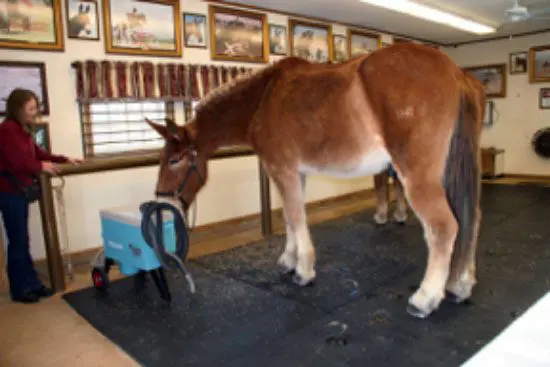 Keep an eye on the pressure you apply whenever using these various grooming tools. Different animals will have different sensitivity to these tools and will tolerate them better if they know you are not going to cause undue pressure or pain. Learn to brush the mane and tail starting at the bottom and working upward, and use a conditioner such as baby oil to keep from pulling or breaking the hair. (Baby oil will also keep other equines from chewing on the tail.) A shedding blade can be an uncomfortable grooming tool when used improperly. When using a shedding blade to remove mud around the head and ears and even on your animal’s body, be careful to minimize his discomfort by monitoring the pressure you apply to each area and working VERY slowly. When bathing him, be extra careful not to get water in his eyes or ears. These types of consideration for your equine’s comfort will help build his trust and confidence in you, and it will help make training easier and more enjoyable for both of you.
Keep an eye on the pressure you apply whenever using these various grooming tools. Different animals will have different sensitivity to these tools and will tolerate them better if they know you are not going to cause undue pressure or pain. Learn to brush the mane and tail starting at the bottom and working upward, and use a conditioner such as baby oil to keep from pulling or breaking the hair. (Baby oil will also keep other equines from chewing on the tail.) A shedding blade can be an uncomfortable grooming tool when used improperly. When using a shedding blade to remove mud around the head and ears and even on your animal’s body, be careful to minimize his discomfort by monitoring the pressure you apply to each area and working VERY slowly. When bathing him, be extra careful not to get water in his eyes or ears. These types of consideration for your equine’s comfort will help build his trust and confidence in you, and it will help make training easier and more enjoyable for both of you.
Tack and Equipment
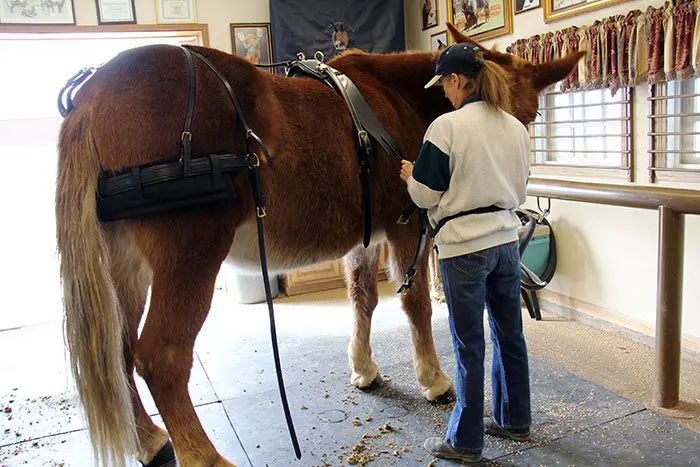 In order to elicit the correct response from your equine, always make sure you are using the correct tack for whatever you are doing. If you are not sure about what tack to use when, go to the Lucky Three Ranch website for more detailed information, or ask the experts in your area. Make sure all tack and equipment fits your animal properly. If it doesn’t, it can cause adverse behaviors during training.
In order to elicit the correct response from your equine, always make sure you are using the correct tack for whatever you are doing. If you are not sure about what tack to use when, go to the Lucky Three Ranch website for more detailed information, or ask the experts in your area. Make sure all tack and equipment fits your animal properly. If it doesn’t, it can cause adverse behaviors during training.
In the Round Pen
Once your equine is leading well in the small pen, he should be in consistently good posture with square halts, easily negotiating trail obstacles in the open and relatively relaxed while at the work station, he is ready to move to the round pen.
Once in the round pen, you will have an opportunity to assess your animal’s progress so you can begin work on balancing on the circle in good posture and conditioning the hard muscle masses in preparation for performance. The size of your round pen is important—45 feet in diameter is ideal. If it is any larger, as you will have difficulty reaching him with the lunging whip, which means you won’t be able to have enough control over him. If your round pen it is any smaller, it will interfere with your equine’s balance and ability to develop the right muscle groups. It should be made with relatively solid walls and be high enough so your animal cannot jump out. Your round pen can be made of a variety of different of materials, such as 2-inch by 12-inch boards and posts or stock panels. Never use electric fencing, pallets, tires or other non-solid materials. The ground surface should be a three- to four-inch–thick base of soft dirt or sand.
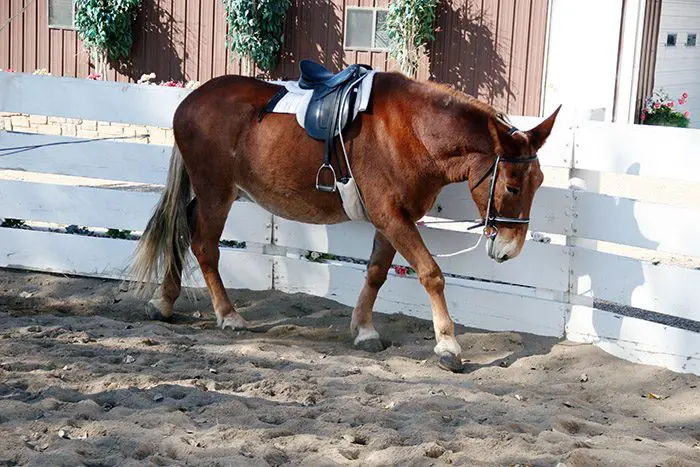 While working in the round pen, be aware of how your own body language and verbal commands elicit certain behaviors in your animal. If something isn’t working right, look to yourself and ask yourself what you might be doing to cause the adverse behavior you are seeing. Equines are very honest about their responses, and if they are not doing what you expect, it has to be in the way you are asking. Also, don’t hurry your equine. When asking for the walk, make sure that the walk is even in cadence, balanced and regular—not hurried. Only after your animal is correct in his execution of one gait, should you move on to the next gait. When first introduced to the round pen, it is not uncommon for an equine to begin work at the trot and then, as he becomes more comfortable with the new area, at the walk.
While working in the round pen, be aware of how your own body language and verbal commands elicit certain behaviors in your animal. If something isn’t working right, look to yourself and ask yourself what you might be doing to cause the adverse behavior you are seeing. Equines are very honest about their responses, and if they are not doing what you expect, it has to be in the way you are asking. Also, don’t hurry your equine. When asking for the walk, make sure that the walk is even in cadence, balanced and regular—not hurried. Only after your animal is correct in his execution of one gait, should you move on to the next gait. When first introduced to the round pen, it is not uncommon for an equine to begin work at the trot and then, as he becomes more comfortable with the new area, at the walk.
If you just let your equine go in an unrestricted frame, he can build muscle incorrectly, which will most likely cause problems later on. To be sure you are building muscle evenly throughout his body, in the correct posture and on both sides, use the “Elbow Pull” self-correcting restraint I devised, as described in DVD #2 of Training Mules & Donkeys.
As explained in DVD #1 of Training Mules & Donkeys, while you were doing passive exercises on the lead rope in the small pen, you were also building the core muscle groups that are closest to the bone. Now that you are in the round pen, you will begin to build your equine’s bulk muscle in strategic areas that will strengthen him and make carrying a rider or pulling a cart a lot easier for him. It will also minimize the chance for soreness or injury, as well as resistant behaviors. Keep sessions short, 30-40 minutes, and only every other day at the most. When muscles are exercised, they need to be stressed to a point just before fatigue, and then rested afterwards for one day before repeating. This is the correct and safe way to build muscle. Any other approach will cause fatigue and actually start deteriorating muscle tissue. Remember to use relaxation techniques and warm-up and cooling down exercises with your equine before and after every workout.
In the Arena
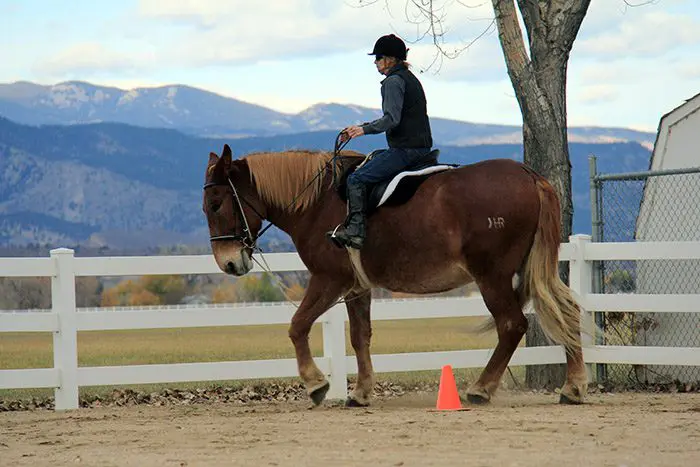 The arena is the place to really start focusing on forward motion and lateral exercises to further strengthen your equine, and it is the place to begin fine-tuning his balance while he is carrying a rider. The arena is also a good place for you to fine-tune your own riding skills, so that you learn to help your equine maintain good balance and cadence, on straight lines and while bending through the corners. In order for your equine to correctly go through the corners, you will be asking him to bend the muscles through his ribcage so he can remain upright and balanced. Equines are not motorcycles and should not lean around the corners. The power should always come from the hindquarters to keep the front end light, supple and responsive to cues. If his front end is heavy and sluggish, your equine is not adequately stepping underneath with his hind legs and will thus, lose forward impulsion and power and will not properly condition his muscles.
The arena is the place to really start focusing on forward motion and lateral exercises to further strengthen your equine, and it is the place to begin fine-tuning his balance while he is carrying a rider. The arena is also a good place for you to fine-tune your own riding skills, so that you learn to help your equine maintain good balance and cadence, on straight lines and while bending through the corners. In order for your equine to correctly go through the corners, you will be asking him to bend the muscles through his ribcage so he can remain upright and balanced. Equines are not motorcycles and should not lean around the corners. The power should always come from the hindquarters to keep the front end light, supple and responsive to cues. If his front end is heavy and sluggish, your equine is not adequately stepping underneath with his hind legs and will thus, lose forward impulsion and power and will not properly condition his muscles.
Open Areas
Open areas are good for stretching and relaxing at all three gaits. They can be used for negotiation of obstacles and to execute large flowing patterns. You can also practice stretching exercises, as described in DVD #5 of Training Mules & Donkeys. Then proceed to working on more collection on the short sides of the arena, and go back to stretching exercises again before you quit the lesson. The open areas allow for a wide variety of training exercises by giving you the space to use numerous patterns and obstacles. Try using cones to mark your patterns—this benefits both you and your animal by helping you both stay focused. An arena without cones is like a house without furniture.
As far as the open road and in traffic, these areas are forseasoned animals only, so please do not even consider using these areas to school your equine—the results could be disastrous! With the heavy traffic these days, it is really safest to avoid heavily traveled roads entirely. For a pleasureable experience, stick to areas where you and your equine will be safe and comfortable.
To learn more about Meredith Hodges and her comprehensive all-breed equine training program, visit LuckyThreeRanch.com, MEREDITH HODGES PUBLIC FIGURE Facebook page, or call 1-800-816-7566. Check out her children’s website at JasperTheMule.com. Also, find Meredith on Pinterest, Instagram, MeWe, YouTube and Twitter.
Covered in TRAINING MULES & DONKEY: A LOGICAL APPROACH TO TRAINING, TRAINING WITHOUT RESISTANCE and EQUUS REVISITED at www.luckythreeranchstore.com.
© 2004, 2005, 2013, 2016, 2018, 2024 Lucky Three Ranch, Inc. All Rights Reserved.





